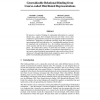Free Online Productivity Tools
i2Speak
i2Symbol
i2OCR
iTex2Img
iWeb2Print
iWeb2Shot
i2Type
iPdf2Split
iPdf2Merge
i2Bopomofo
i2Arabic
i2Style
i2Image
i2PDF
iLatex2Rtf
Sci2ools
NIPS
2001
2001
Generalizable Relational Binding from Coarse-coded Distributed Representations
We present a model of binding of relationship information in a spatial domain (e.g., square above triangle) that uses low-order coarse-coded conjunctive representations instead of more popular temporal synchrony mechanisms. Supporters of temporal synchrony argue that conjunctive representations lack both efficiency (i.e., combinatorial numbers of units are required) and systematicity (i.e., the resulting representations are overly specific and thus do not support generalization to novel exemplars). To counter these claims, we show that our model: a) uses far fewer hidden units than the number of conjunctions represented, by using coarse-coded, distributed representations where each unit has a broad tuning curve through high-dimensional conjunction space, and b) is capable of considerable generalization to novel inputs.
Coarse-coded Conjunctive Representations | Conjunctive Representations | NIPS 2001 | NIPS 2007 | Temporal Synchrony |
| Added | 31 Oct 2010 |
| Updated | 31 Oct 2010 |
| Type | Conference |
| Year | 2001 |
| Where | NIPS |
| Authors | Randall C. O'Reilly, R. S. Busby |
Comments (0)

